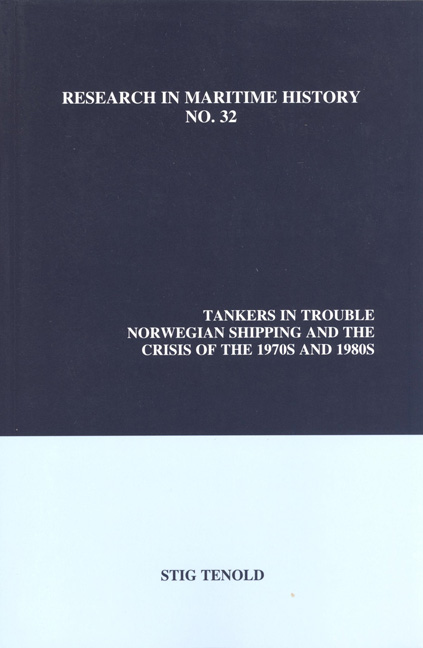Book contents
- Frontmatter
- Table of Contents
- List of Tables in the Text
- List of Illustrations
- Preface
- Chapter 1 Introduction
- Chapter 2 The Shipping Market after World War II
- Chapter 3 The Basis of the Tanker Crisis
- Chapter 4 The Contagion and Short-term Effects of the Crisis
- Chapter 5 Stage Two of the Crisis and the Long-term Changes
- Chapter 6 The Basis for the Crisis in Norwegian Shipping
- Chapter 7 Structural Transformations in Norwegian Shipping
- Chapter 8 The Fates of Four Norwegian Shipowners
- Chapter 9 Conclusion
- Appendices
- Bibliography: Select Bibliography
Chapter 5 - Stage Two of the Crisis and the Long-term Changes
- Frontmatter
- Table of Contents
- List of Tables in the Text
- List of Illustrations
- Preface
- Chapter 1 Introduction
- Chapter 2 The Shipping Market after World War II
- Chapter 3 The Basis of the Tanker Crisis
- Chapter 4 The Contagion and Short-term Effects of the Crisis
- Chapter 5 Stage Two of the Crisis and the Long-term Changes
- Chapter 6 The Basis for the Crisis in Norwegian Shipping
- Chapter 7 Structural Transformations in Norwegian Shipping
- Chapter 8 The Fates of Four Norwegian Shipowners
- Chapter 9 Conclusion
- Appendices
- Bibliography: Select Bibliography
Summary
By the mid-1970s the problems in the tanker market had evolved into a fullfledged shipping crisis, and no part of the shipping sector was unaffected by the calamities. But at the end of 1978 the prospects suddenly looked much brighter, and it seemed as though the problems were nearing an end. Yet this proved to be just a temporary reprieve, and in the first half of the 1980s the situation deteriorated even further.
The shipping crisis implied drastic changes in freight rates, vessel values and capacity utilisation. When the mismatch between supply and demand was temporarily reduced near the end of the 1970s, the markets responded quickly, leading to a rapid increase in freight rates, ship values, contracting and capacity utilisation. In the period from March to December 1979, tanker lay-up rates were reduced by approximately two-thirds. The spot market for Very Large Crude Carriers (VLCCs) and Ultra Large Crude Carriers (ULCCs) rose from Worldscale (W) twenty-two in February to a peak at W seventy-one five months later, and the value of the largest class of tankers almost doubled between 1978 and 1979. Moreover, the volume of tanker tonnage ordered increased from three million deadweight tons (dwt) in 1978 to more than fourteen million dwt the following year.
Although the improved conditions around the turn of the decade were merely a false recovery, it makes sense to analyse the two stages of the shipping crisis independently, since the basis for the second stage differed from the first. In the 1970s the problems were caused by lower-than-expected demand growth and a massive tonnage increase. Stickiness caused by the length of time between ordering and delivery and the high cost of cancellations meant that the fleet grew while demand stagnated.
In the first half of the 1980s there was an absolute reduction in shipping demand. Even a reduction in the tanker fleet was insufficient to neutralise the negative effects. The basis was an absolute decline in oil consumption and transport, following the strong increase in oil prices in 1979/1980. The movement of crade oil in 1985 was less than forty percent of the volume in the peak year of 1977.
- Type
- Chapter
- Information
- Tankers in TroubleNorwegian Shipping and the Crisis of the 1970s and 1980s, pp. 85 - 106Publisher: Liverpool University PressPrint publication year: 2006



